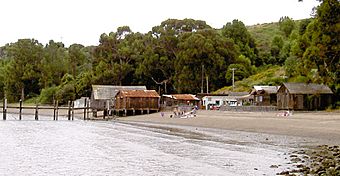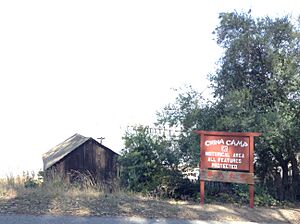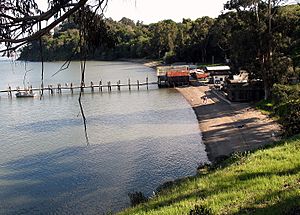China Camp State Park facts for kids
Quick facts for kids |
|
|
China Camp
|
|

China Camp in 2010
|
|
| Location | San Rafael, California |
|---|---|
| Area | 75 acres (30 ha) |
| Built | 1865–1925 |
| NRHP reference No. | 79000493 |
| Added to NRHP | April 26, 1979 |
China Camp State Park is a special place in Marin County, California. It has a historic Chinese American village where people used to fish for shrimp. The park also protects a salt marsh and beautiful natural areas. You can find it in San Rafael, California, right on the edge of San Pablo Bay.
This park is famous for its fun hiking and mountain biking trails. It offers amazing views and lots of open space to explore. The park covers about 1,514 acres and was created in 1976. A smaller part, about 75 acres, includes the old shrimping village. This area was added to the National Register of Historic Places in 1979. It is important for its history, buildings, trade, and how people lived there. China Camp State Park is also part of the San Francisco Bay National Estuarine Research Reserve.
Contents
History of China Camp
Early People in the Area
Long ago, before the 1700s, the Coast Miwok people lived here. They hunted animals, gathered acorns from oak trees, and fished in the bay. In 1775, Spanish settlers arrived and built Mission San Rafael Arcángel nearby. Sadly, many Miwok people were gone within 100 years.
In 1844, a man named Timothy Murphy received a large piece of land from the Spanish. He was an Irish settler and became the mayor of San Rafael. When the United States took over California in 1846, Murphy lost most of his land. After he died, the land went to John and George McNear. They were businessmen who started a big dairy farm, a quarry, and a brickyard. Many Chinese immigrants worked for these businesses and began to live in the area.
Chinese Village Life
By the 1880s, a Chinese American village grew at China Camp. About 500 people lived there, many from Canton, China. They made a living by catching shrimp in San Pablo Bay. Some also worked at local businesses. At its busiest, the village had three general stores, a marine supply shop, and a barber shop.
China Camp was one of about 26 similar shrimp-fishing villages. Chinese Americans built these villages along the coast. Many had moved from San Francisco to escape unfair treatment. After the 1906 San Francisco earthquake, China Camp's population grew to 10,000 people. Many came from San Francisco's Chinatown to escape the damage.
In the late 1800s, fishermen at China Camp caught millions of pounds of shrimp each year. Much of it was sent to China and Hawaii. But in the early 1900s, new laws hurt the village's economy. These laws stopped shrimp exports and banned certain fishing nets. They also closed the best shrimping times. Because of this, most people left China Camp. Only one family, the Quans, kept fishing for shrimp.
In 1914, a new type of net called a trawl was invented. This helped the Quans catch a lot of shrimp again. They could process 5,000 pounds of shrimp daily. The family also ran other businesses. They had a general store, rented boats, and ran a cafe. This cafe served both villagers and visitors who came for outdoor fun.
How the Park Was Created
By the 1960s, a developer named Chinn Ho owned much of the land around the village. The number of shrimp in San Pablo Bay had also dropped. This was due to water pollution and other changes. Still, Frank Quan, a grandson of the first Quan family member, kept fishing. He was the last Quan living in the village. He mostly sold his shrimp for bait.
In the early 1970s, a company wanted to build many tall buildings and shops in the area. Local people and environmental groups protested this plan. As a result, the land was sold in 1976. A nonprofit group bought it for about $2.3 million. They then sold it to the state of California to create China Camp State Park. Chinn Ho also gave the 36-acre village site to be preserved. It became a memorial to Chinese American history. The park plan allowed Frank Quan to keep living in the village.
Saving the Park in 2011
In 2011, China Camp State Park was one of 70 parks set to close. This was due to budget cuts in California. People in Marin County worried the park would fall apart if it closed. The historic Chinese village was especially at risk. Frank Quan, who was 85 at the time, said it was the last village with original buildings left. The state parks department said China Camp was losing money. They claimed they could not afford to keep it open.
Local groups like the Marin State Parks Association and Friends of China Camp worked to save the park. They raised money and protested the closure. An investigation later showed the state parks department had extra money they hadn't reported. This led to changes in leadership. Eventually, an agreement was made. China Camp State Park would be funded by both the state and the Marin State Park Association. The association would also help run the park.
In 2013, a new agreement was made. The nonprofit group Friends of China Camp continues to run China Camp State Park today. They do this without funding from the state. Frank Quan passed away in August 2016 at age 90. He was still living at the park he helped save.
Fun Activities at the Park
China Camp State Park offers many outdoor activities for everyone. You can go camping overnight or have a picnic. There are trails for hiking and biking. You can also enjoy water sports like kayaking, paddleboarding, and sailing.
Every August, China Camp celebrates Chinese-American Heritage Day. This special event includes exciting lion dances and amazing acrobatic shows. You can also see tai chi demonstrations. There are arts and crafts for sale and fun activities for children. A replica of a Chinese junk boat, called the Grace Quan, often visits. Other historic boats are also sometimes there.
Images for kids
See also
- Chinese American history
- List of California state parks
- National Register of Historic Places listings in Marin County, California









